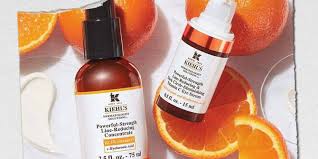
Can I Use Vitamin C and Hyaluronic Acid Together? Skincare Experts Explain
If you’re into skincare, you’ve probably heard of vitamin C and hyaluronic acid. They’re two of the most powerful and popular ingredients on the market—and for good reason.
Hyaluronic acid is considered one of the most effective hydrating ingredients available. It’s known for drawing moisture into the skin and locking it in.
This is thanks to its humectant properties, which means it attracts water molecules from the surrounding environment and other skincare products.
When applied to the skin, hyaluronic acid helps keep it soft, supple, and visibly plump. It also strengthens the skin barrier and soothes irritation from stronger actives.
Vitamin C, on the other hand, is a powerhouse antioxidant that works to brighten skin tone, reduce signs of aging, and protect against sun damage.
When combined, hyaluronic acid and vitamin C offer a duo of hydration and protection. Together, they can leave your skin radiant, healthy, and glowing.
So yes, you absolutely can use them together. But to get the best results, it’s important to know how to apply them—and what to avoid.
What Should Go First: Vitamin C or Hyaluronic Acid?
When layering skincare, the order matters. If you want both ingredients to work well, you need to apply them in the correct sequence.
If you’re using separate products, always apply vitamin C first, followed by hyaluronic acid.
Vitamin C serums are typically thinner and absorb quickly. They’re designed to deliver antioxidants directly into the skin.
This provides essential protection against environmental stressors like pollution, UV rays, and blue light.
By applying vitamin C first, you allow the skin to absorb its full benefits without any barriers.
Follow this with hyaluronic acid. Its main job is to hydrate and seal in moisture, which supports the function of your skin barrier.
Think of it like this: vitamin C protects your skin from daily damage, and hyaluronic acid keeps it calm, plump, and moisturized.
Why Do They Work So Well Together?
Vitamin C can sometimes be irritating—especially for people with sensitive skin or when it’s used at high concentrations.
That’s where hyaluronic acid comes in. It helps soothe and hydrate the skin after vitamin C is applied, reducing the chance of irritation or dryness.
The result? A balanced, radiant complexion that looks and feels refreshed.
Using both ingredients regularly can improve skin texture, fade dark spots, prevent premature aging, and deeply hydrate the skin—all at the same time.
Together, they form a powerful skin-reviving duo that supports your glow, protects your skin, and maintains a strong moisture barrier.
What Should You Avoid Mixing with Hyaluronic Acid?
Here’s some good news: hyaluronic acid plays well with almost every ingredient.
It’s one of the most versatile actives in skincare. Whether your routine includes retinol, acids, peptides, or vitamin C, hyaluronic acid fits right in.
It’s gentle, non-irritating, and safe for all skin types—including sensitive and acne-prone skin.
However, while HA itself is non-reactive, always check the full ingredient list of the product you’re using. Sometimes, irritants can be hidden in the formula.
When in doubt, perform a 24-hour patch test on a small area before applying any new product all over your face.
And of course, speak to a dermatologist if you have specific skin concerns or medical conditions.
What Should You Not Mix with Vitamin C?
Vitamin C is an amazing ingredient, but it’s potent—and sometimes tricky.
It needs to be used with care and ideally not layered with other strong actives unless you’re following expert advice.
Here are some ingredients that don’t pair well with vitamin C:
1. Vitamin C + Benzoyl Peroxide
Both ingredients are effective but highly active. Benzoyl peroxide can oxidize vitamin C, reducing its effectiveness.
Using them together may also lead to dryness or peeling—especially if your skin is already sensitive.
Instead, use vitamin C in the morning and benzoyl peroxide at night to keep your skin calm and protected.
2. Vitamin C + Retinol
These are two of the most powerful ingredients in skincare, but using them at the same time can overwhelm your skin.
Layering them together may cause redness, dryness, or irritation. That doesn’t mean you can’t use both—just not at once.
Apply vitamin C in the morning for antioxidant protection, and use retinol in the evening to promote skin renewal.
3. Vitamin C + Niacinamide
This combo used to be a no-go. In older formulas, combining these two ingredients could create a reaction that made both less effective.
Today, thanks to modern formulation techniques, using vitamin C and niacinamide together is generally safe—but not always ideal.
To be cautious, apply them at different times of the day or alternate days, especially if you have sensitive skin.
4. Vitamin C + AHAs/BHAs
Vitamin C already has a low pH and can exfoliate mildly on its own. Adding AHAs (like glycolic acid) or BHAs (like salicylic acid) increases the chance of irritation.
If you want to use both, space them out. Use exfoliating acids a few times per week, preferably at night, and vitamin C in the morning.
If your skin feels tight, itchy, or red, switch to alternating days to give your skin time to recover.
Do You Need Moisturizer After Using Hyaluronic Acid?
You might think hyaluronic acid replaces the need for a moisturizer. While HA is super hydrating, it doesn’t always seal in moisture on its own.
That’s why applying a moisturizer after hyaluronic acid is a good idea—especially in dry or cold climates.
HA pulls moisture from its surroundings, including the air and any other products on your skin. Without a moisturizer to lock that hydration in, the moisture could evaporate.
Use a lightweight, fragrance-free moisturizer to form a protective layer on your skin. This ensures hydration stays in place all day.
What’s the Best Way to Use Hyaluronic Acid?
It depends on the type of product you’re using. But here’s a general rule: apply products from thinnest to thickest.
Hyaluronic acid is most commonly found in serums, which should be applied after cleansing and toning, but before moisturizer and sunscreen.
You can also find HA in moisturizers, creams, and even mists. No matter the form, it should be applied while your skin is still slightly damp to maximize absorption.
Applying HA on dry skin may actually draw moisture out of your skin rather than locking it in. Damp skin = deeper hydration.
A Simple Skincare Routine Using Both Ingredients
Here’s how to safely layer vitamin C and hyaluronic acid in your morning routine:
Cleanser: Start with a gentle cleanser to remove dirt and prep your skin.
Toner (optional): Use a hydrating or calming toner, especially if your skin feels dry.
Vitamin C Serum: Apply a few drops and let it absorb for 1–2 minutes.
Hyaluronic Acid Serum: Layer this on top to hydrate and calm the skin.
Moisturizer: Seal everything in with a nourishing, fragrance-free moisturizer.
Sunscreen: Always finish with SPF 30 or higher, even on cloudy days.
If you’re using stronger actives like retinol, exfoliating acids, or acne treatments, save those for nighttime or alternate days.
Final Thoughts: Should You Use Vitamin C and Hyaluronic Acid Together?
Absolutely! These two ingredients are a dream team for anyone looking to boost hydration, improve skin tone, and protect against environmental damage.
Vitamin C defends and brightens, while hyaluronic acid hydrates and soothes.
Just remember to layer correctly: vitamin C goes first, hyaluronic acid second, followed by a moisturizer and SPF.
Be cautious when combining vitamin C with other strong actives. When in doubt, consult a dermatologist or simplify your routine.
Give your skin the love it deserves, and you’ll enjoy a glowing, healthy complexion every day.


